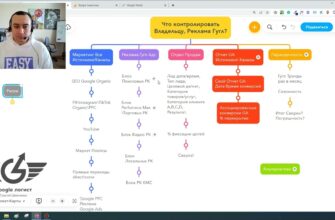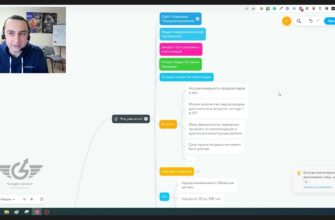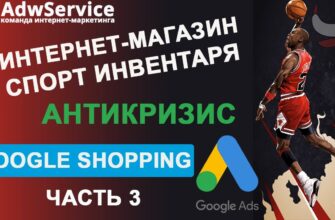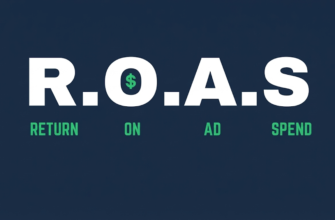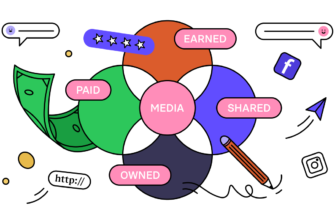- What is ROMI?
- Why calculate ROMI?
- What are the disadvantages of ROMI?
- How to calculate ROMI (formula)?
- Let’s calculate ROMI for a real advertising campaign (example)
- What kind of ROMI is considered good?
- When is it useful to calculate ROMI?
- When is ROMI not effective?
- How can ROMI be increased?
- What is the difference between ROMI and ROI or ROAS?
Marketing is an investment in the growth and development of an enterprise. But how do you know how well these investments are paying off? Do they make a profit or do they just eat up the company’s budget? The answer to these questions is provided by ROMI, the return on marketing investment ratio.
It allows you to assess the return on investment in marketing activities. Moreover, this KPI is important for any business – from small startups to large corporations. After all, every hryvnia spent should be returned to the company owner in the form of sales and profit growth.
In this article, we will try to understand what ROMI is, how it differs from ROI, and how to calculate it using a specific example. We will also talk about who should rely on it in their work and in what situations this KPI is not relevant.
How many calls and sales will I get by ordering contextual advertising from you?
I need to calculate the conversion of my website Describe
the task
in the application
Calculate potential ad revenue Google
contextual advertising calculator
What is ROMI?
ROMI (an acronym for Return on Marketing Investment) is one of the main indicators of marketing campaign performance that reflects the return on investment in advertising. In simple terms, ROMI shows how much each hryvnia spent on promotion brought you.
Unlike ROI, which takes into account the overall effectiveness of all investments, ROMI is focused on marketing costs. This makes it possible to evaluate the return on advertising, PR, content marketing, SEO, and other tools.
Its calculation does not include operating expenses for production, staff salaries, office rent, and other items not directly related to advertising. Thanks to this, we get a clear picture of how effective individual traffic channels and customer acquisition campaigns are.
Let’s say an online store sells designer furniture and uses targeted advertising on social media, contextual advertising in Google Ads, email campaigns, and a blog. To figure out which of these channels bring in money, marketers calculate ROMI for each direction. This helps to identify growth points and cut off inefficient areas that don’t generate revenue.
Why calculate ROMI?
The main task of this indicator is to indicate how advertising costs affect revenue. Let’s say an online store launched a large-scale New Year’s sale and allocated an impressive budget for advertising. Afterwards, you received 1000 new orders totaling 250,000 UAH. Was it a success? Not a fact.
To determine the effectiveness, you should calculate the ROMI. So, if 350000 UAH were spent on promotion, there was no profit, and despite the impressive number of sales, there was a serious loss. But if the cost was only 50,000 UAH, the campaign paid off 5 times over.
In addition, the ROMI calculation will help you:
- Identify the most profitable and unprofitable advertising channels.
- Redistribute bets in favor of the most effective platforms and tools.
- Identify weaknesses and growth areas in the current marketing strategy.
- Make adjustments to campaign settings to achieve better results.
- Compare your performance with competitors.
Knowing the ROMI also helps you calculate what the average cost of an application, product price, and check size should be to break even. This way, you can easily set realistic goals and predict your return on investment.
It’s also a great tool to help evaluate the profitability of one-off promotions, whether it’s Black Friday, the launch of a new service or a seasonal sale. With its help, you can quickly understand if it makes sense to repeat such activities in the future.
What are the disadvantages of ROMI?
- Doesn’t describe the full picture. This metric only assesses ROI, but does not take into account other factors that affect profit. For example, advertising costs are recouped, but you are left with a loss due to high cost of goods or inefficient production.
- It is difficult to track the customer journey. Today, users interact with a brand through multiple touchpoints. A person may see an ad on Facebook, then sign up for an email newsletter, study reviews of a company on a marketplace, and a week later place an order over the phone. It can be extremely difficult to track this path and link conversions to a specific advertising channel. As a result, the ROI may show that no advertising tool has worked, and the sale is related to the direct entry of the user to the site (although in reality this is not the case).
- Deferred effect. For example, after the launch of an image campaign, ROMI may be at a disadvantage, because people do not usually make a purchase immediately after seeing such advertising. But in six months, these same users will come back and buy the product because they have memorized the brand. Here ROMI will give a distorted picture.
- It is not suitable for all advertising channels. For example, content marketing and search engine optimization pay off after months or even years of work by specialists. A company spends resources on blogging, but the first orders arrive only after a year. It’s the same with brand promotion or a loyalty program.
How to calculate ROMI (formula)?
To calculate ROMI, you need to use the following formula:

By “advertising revenue” we mean all funds received from contextual advertising campaigns, SEO, email distribution, targeted ads in social networks. And “investment in advertising” is all the money invested in clicks, development of creatives, payment for the work of specialists to customize campaigns, the cost of subscriptions to services, content production, etc.
To calculate everything, you need to find the difference between the incoming profit and expenses, and then divide the resulting number by the amount of money spent. The result is multiplied by 100% to get the value in percent.
So, for example, an online store spent UAH 200,000 on Facebook targeting and email newsletters. This brought in revenue of 800,000 hryvnias. Substituting the figures:
(800 000 – 200 000) / 200 000 x 100% = 300%
How many calls and sales will I get by ordering contextual advertising from you?
I need to calculate the conversion of my website Describe
the task
in the application
Calculate potential ad revenue Google
contextual advertising calculator
Thus, each hryvnia invested in advertising brought three, and the return on investment amounted to 300%. A magnificent result!
The tortured ROMI values can be interpreted as follows:
- Less than 0%. Our expenses exceeded our profits. For example, a ROMI of -50% means that the company has lost half of the money invested in marketing. It is necessary to globally revise the overall advertising strategy – perhaps to completely disable the traffic source under study, as it is not in demand among the target audience.
- Equals 0%. This is the break-even point. The profit covers the advertising costs, but the campaign does not generate any revenue. With this result, the company’s performance is usually minus, as the indicator only considers advertising costs and not the total cost of running the business.
- Above 0%. This is the value of ROMI we should strive for. It tells us that each invested hryvnia not only returned back, but also brought income. The higher the percentage, the better the return on investment. For example, with ROMI of 100% – each hryvnia brought two, i.e. it paid off twice as much.
Let’s calculate ROMI for a real advertising campaign (example)
Suppose an online electronics store has launched a campaign in TikTok and Instagram, timed to coincide with the start of the school year. The goal is to attract the attention of students and schoolchildren to new laptop models.
- The campaign is known to have generated gross revenue of 250,000 ₴.
- The margin on each laptop sold is an average of 20%.
- Multiply the figures among themselves to find out the resulting profit – 250,000 * 20% = 50,000 ₴.
- Let’s calculate the expenses. The company spent 20,000 on clicks on advertising. Plus add the cost of producing creatives (5,000) and paying a targeting specialist (10,000). Total – 35,000 ₴.
Substituting the data into the final formula:
ROMI = (50,000 – 35,000) / 35,000 * 100% = 43%
We got a good result, because the campaign not only pays off, but also brings income – for the hryvnia invested in advertising we got another 43 kopecks on top. This marketing channel works to a plus, and we can try to scale it up.
What kind of ROMI is considered good?
There is no universal benchmark, because the indicator depends on many factors – niche, specifics of the goods sold, connected traffic sources and even seasonality. It is considered that if ROMI is more than 0%, it is already good, because the campaign is “plus” and each spent hryvnia generates additional income.
However, it is important to realize that even a small positive ROMI is not always a reason to be happy. If it fluctuates within the range of 5-10%, then marketing, in fact, works “at zero”. It brings no tangible profit, but only recoups its own costs.
It is also worth remembering the niche. In the FMCG sector, where the transaction cycle is short and margins are low, a ROMI of 50-70% will be an excellent result. But for B2B companies with a long transaction cycle, this value can be much lower.
In general, 50% and above can be considered a good benchmark. In this way, marketing not only pays off, but also brings additional, albeit small, profit. This is what we should aim for when evaluating the performance of advertising campaigns.
But if the indicator is equal to zero (break-even point) or even less – this is a red flag for any niche. Thus, the indicator signals us that something has gone wrong and the financial results are either at zero or in the negative.
When is it useful to calculate ROMI?
The coefficient will help to provide the most objective picture of the effectiveness of marketing investments in a number of cases:
- You need to compare the effectiveness of different advertising channels or platforms against each other. You’ll see which ones are generating the highest return and can reallocate your budget accordingly.
- You work in a niche where a customer makes a one-time purchase. In such cases, the income is immediately visible and ROMI will show the effectiveness of this or that traffic source. But for areas with a long sales cycle and repeat orders (subscription to services, selling pet food), the connection between advertising and profit is more difficult to trace.
- Your business is not affected by constant fluctuations in demand, purchase prices, average check and other factors. Metrics only perform well in stable conditions, when it is easier to trace a direct link between advertising costs and revenues.
- You need to analyze a launched promotion or a seasonal sale (Black Friday, New Year’s Eve). In this case, the result of investments is visible immediately and it is easy to calculate whether they have paid off.
When is ROMI not effective?
- The company does not collect statistics on sales. If you do not track traffic sources, and incoming orders are not entered into the CRM, it is impossible to make correct calculations. The site must have end-to-end analytics installed, showing the customer’s full path to purchase. Without this, it is impossible to understand what channel brought him there. That is, a person saw a video advertisement, clicked on the link, but at first decided not to buy anything. A week later, he returned from organic search and placed an order. If the analytics are set up incorrectly, the order will be assigned to SEO, although the client was initially attracted by advertising. In this way, the indicators for advertising will be underestimated, and for organics – overestimated.
- High average check. If a company sells expensive goods or services (real estate, cars, luxury goods), customers rarely decide to buy something instantly. It can take months from the first contact with a brand to the final action. Then the ROMI for a short period of time will be unrepresentative – in the month of the advertising launch, the metric will be negative, because the costs have already been incurred, but there are no orders. But after six months, deals will start to close, ROMI will grow sharply and show a different picture.
- A business model with a long cycle. Let’s say a person bought an annual subscription and in the first month the ROMI amounted to 50%. But if the customer renews the subscription for the next year, the lifetime value (LTV) will increase, and, consequently, the real return on investment. Therefore, it is better to calculate ROMI for the entire customer retention cycle or at least for several months to account for repeat sales and presales.
- Image campaigns. This coefficient is poorly suited for evaluating activities that do not produce immediate results but work for brand recognition and audience loyalty – sponsorship of events, social projects, educational content. They lay the foundation for future sales, but their impact on revenue is time-lagged and difficult to measure. If you evaluate them by ROMI, you may get the impression that they are unprofitable and unnecessary. But in the long term, they can become the main driver of growth.
How can ROMI be increased?
- Scale up successful campaigns. If a particular bundle, channel, creative or audience yielded a high ROMI, don’t stop there. Launch several more similar campaigns or increase budgets for existing ones. The “winner takes all” principle works here – successful marketing activities should be strengthened and developed in every possible way.
- Optimize budgets. If some direction brings little money or works at a loss – ruthlessly reduce it. And vice versa, redistribute money in favor of the most effective. This approach will allow you to get more return even without increasing total costs.
- Use end-to-end analytics. Set up data transfer between advertising platforms, website and CRM. Use utm tags and analytics counters. This will help identify “holes” in the funnel and points of efficiency growth.
- Increase the relevance of creatives. Even the most trafficked channel will not give a high rate if ads do not hit the needs of the CA. Constantly test different hypotheses, study your audience, adapt messeges and offerers. The more precise the targeting and better personalization, the higher the response and conversion.
- Work with leads on the site. If advertising traffic lands on an awkward landing page – some potential buyers will inevitably drop out. To avoid this, simplify navigation, improve search, work with objections right on the site. Turn each page into a full-fledged tool with clear calls to action. The less effort it takes for a visitor to become a customer – the higher the ROMI.
- Experiment. When some channel brings little sales – do not rush to write it off. Perhaps the problem is not in it, but in the wrong approach to work with it. Try changing messages, ad formats, time and frequency of displays. Segment your audience, make personalized offers. Then the “dead” can suddenly come to life and give a high ROMI.
- Train your sales team. Even the hottest lead can leave if the manager doesn’t pick up the phone for a long time or can’t clearly talk about the product. Therefore, regularly pump up the skills of salespeople, practice scripts, conduct trainings on working with objections.
- Increase the average check. ROMI directly depends on margin and sales volume. Actively use presales and cross-selling techniques: offer customers more expensive versions of products, additional goods as a gift, extended warranties. Encourage repeat purchases with loyalty programs and special offers for existing customers.
What is the difference between ROMI and ROI or ROAS?
It is important to understand the difference between ROMI and ROI and ROAS, because these are three indicators that are often confused, even though they perform different tasks. Let’s find out what their key differences are.
ROI in this case is the broadest indicator, taking into account the return on all investments in the project. It includes not only marketing costs, but also the costs of purchasing materials, equipment, employee salaries, office rent, and any other expenses. The metric shows the overall profitability and profitability of a business or an individual product.

ROMI, on the other hand, focuses exclusively on advertising investments. With it, it is possible to assess how well investments in advertising perform and what profit they generate. Thus, this metric gives a narrower and more accurate assessment of the profitability of a company’s marketing activities.
ROAS (Return on Advertising Spend) is an even narrower indicator. It evaluates not the entire marketing budget, but individual campaigns, ads, platforms and even keywords. With its help, you can find out which tools are profitable and which are not. For example, to compare the return on contextual and targeted advertising.

It is important to realize that the values of these metrics are interpreted differently. For example, ROMI of 100% indicates that marketing investments have paid off and brought profit by a factor of 2. But ROAS of 100% is the break-even point, when advertising costs are equal to the income from it. Profit appears when ROAS is above 100%.




